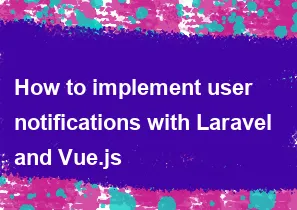How to implement user notifications with Laravel and Vue.js

Implementing user notifications with Laravel and Vue.js involves creating a system where your Laravel backend sends notifications to the frontend, and Vue.js handles the display and interaction with these notifications. Laravel provides a convenient way to manage notifications, and Vue.js can be used to dynamically update the user interface based on these notifications.
Here's a step-by-step guide on how you can implement user notifications using Laravel and Vue.js:
Laravel Backend:
Install Laravel Echo and Pusher: Ensure you have Laravel Echo and Pusher installed. You can install them using Composer:
bashcomposer require pusher/pusher-php-serverConfigure your
.envfile with your Pusher credentials.Create Notification: Create a notification using Laravel's artisan command:
bashphp artisan make:notification UserNotificationUpdate the
toBroadcastmethod in theUserNotificationclass to broadcast the notification to Pusher.Broadcast Event: Create an event class that will be broadcast to Pusher. You can use Laravel's
broadcastmethod in your controller or use events to trigger broadcasts.phpbroadcast(new UserNotification($user));Ensure your event class implements
ShouldBroadcast.
Vue.js Frontend:
Install Laravel Echo and Pusher: Install the necessary packages for Laravel Echo and Pusher in your Vue.js project:
bashnpm install --save laravel-echo pusher-jsConfigure Laravel Echo: Set up Laravel Echo in your
resources/js/bootstrap.jsfile:jsimport Echo from 'laravel-echo'; window.Echo = new Echo({ broadcaster: 'pusher', key: process.env.MIX_PUSHER_APP_KEY, cluster: process.env.MIX_PUSHER_APP_CLUSTER, encrypted: true, });Create Vue Component: Create a Vue component that will handle the display of notifications. You can use a Vuex store to manage the state of notifications.
Listen for Events: Use Laravel Echo to listen for the broadcasted events and update the Vuex store accordingly. You can then use this store to display notifications in your Vue component.
jswindow.Echo.channel('user.' + userId) .listen('UserNotification', (notification) => { // Update Vuex store with the new notification });Display Notifications: Update your Vue component to display notifications from the Vuex store.
Displaying Notifications:
You can display notifications using toasts, modals, or any other UI element. You might want to use a Vue notification library like vue-notification or create your custom components.
Remember to properly handle notification dismissal and other user interactions in your Vue component.
This is a high-level overview, and you might need to adapt it based on your specific requirements. Make sure to consult the official documentation for Laravel Echo, Pusher, and Vue.js for detailed information on configuration and usage.
-
Popular Post
- How to optimize for Google's About This Result feature for local businesses
- How to implement multi-language support in an Express.js application
- How to handle and optimize for changes in mobile search behavior
- How to handle CORS in a Node.js application
- How to use Vue.js with a UI framework (e.g., Vuetify, Element UI)
- How to configure Laravel Telescope for monitoring and profiling API requests
- How to create a command-line tool using the Commander.js library in Node.js
- How to implement code splitting in a React.js application
- How to use the AWS SDK for Node.js to interact with various AWS services
- How to use the Node.js Stream API for efficient data processing
- How to implement a cookie parser middleware in Node.js
- How to implement WebSockets for real-time communication in React
-
Latest Post
- How to implement a dynamic form with dynamic field styling based on user input in Next.js
- How to create a custom hook for handling user interactions with the browser's device motion in Next.js
- How to create a custom hook for handling user interactions with the browser's battery status in Next.js
- How to implement a dynamic form with dynamic field visibility based on user input in Next.js
- How to implement a dynamic form with real-time collaboration features in Next.js
- How to create a custom hook for handling user interactions with the browser's media devices in Next.js
- How to use the useSWRInfinite hook for paginating data with a custom loading indicator in Next.js
- How to create a custom hook for handling user interactions with the browser's network status in Next.js
- How to create a custom hook for handling user interactions with the browser's location in Next.js
- How to implement a dynamic form with multi-language support in Next.js
- How to create a custom hook for handling user interactions with the browser's ambient light sensor in Next.js
- How to use the useHover hook for creating interactive image zoom effects in Next.js